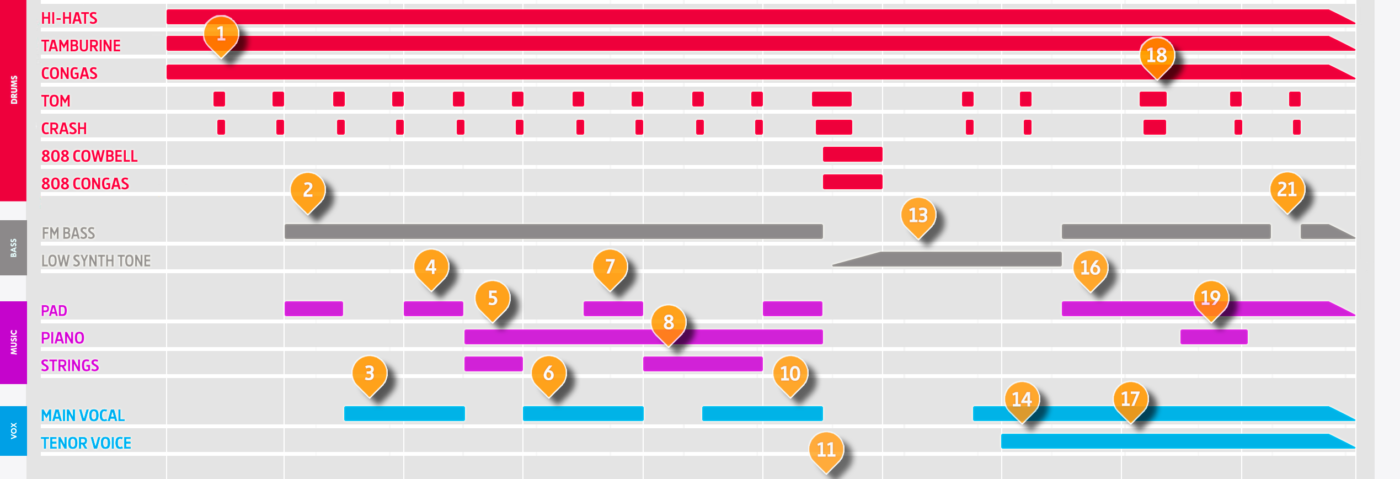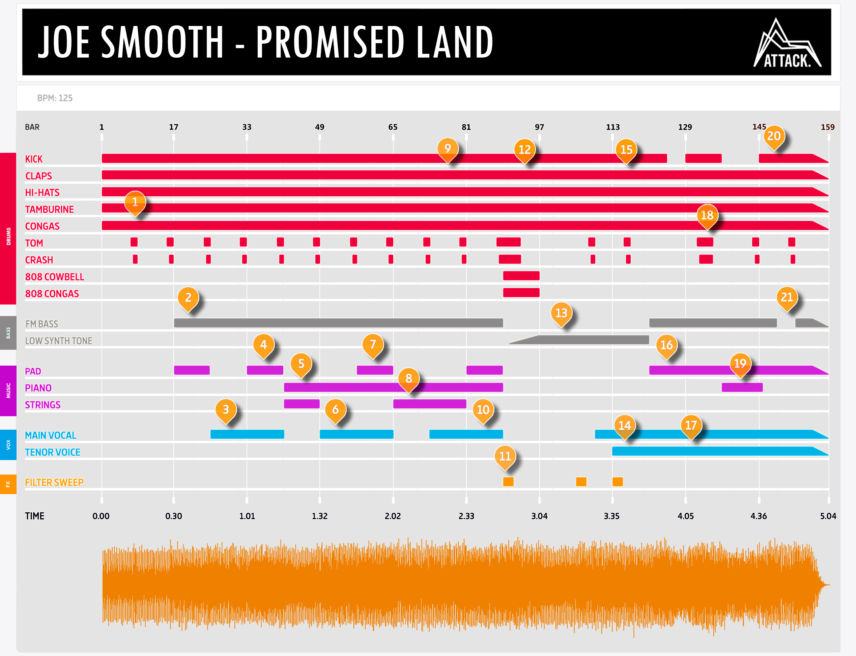For this month’s Deconstructed, we take apart the arrangement of a deep house vocal classic, Joe Smooth’s ‘Promised Land’.
Released in 1987 on DJ International Records, ‘Promised Land’ was an almost immediate dancefloor hit. With its positivity and message of inclusion, it struck a chord on both sides of the pond. What better way to bring awareness to the creative efforts of Black musicians than by taking a deep dive into this classic for the UK’s Black History Month?
A key entry in the genre of deep house, ‘Promised Land’ was inspired by a tour Joe Smooth made of Europe with label mate Farley ‘Jackmaster’ Funk. Despite the language barrier between them and the punters they met, everyone could seemingly come together in harmony on the dancefloor. Smooth was moved by this, and when he got back to the states he recruited a few vocalists and cut the future classic in about a week.
While rooted in the house sound of the late ‘80s, with its song-based arrangement and melodic emphasis, it maintains a timeless feel, and still sounds fresh and liberating in the 21st century. Let’s get out the microscope and see how Smooth put it all together. Note that we’re examining the original mix of the song.
The Track
The Arrangement
What’s Happening
1
The good vibes start with a 16-bar percussion intro. Unlike the more minimal ‘tracks’ that were popular in Chicago in the mid- and late-80s, ‘Promised Land’ has a full arrangement. This applies to the vocals and melody but also to the drums. Programmed at 125bpm, the percussion track is largely built around a Roland TR-707, a popular rhythm machine for Chicago producers. Let’s break it down.
The foundation is of course the kick, which is programmed in a typical four-to-the-floor pattern. There’s a gated reverb on it giving it some presence and length. The downbeat is supplied by a clap, held back in the mix. Closed hats run in a straight sixteenth-note pattern, with open hats programmed on the offbeat and panned to the left. The closed hats are doubled with a tambourine to help them stand out in the mix a bit. There’s a tom fill at the end of each eight-bar section, followed by a crash, also pushed back in the mix. The tom and crash fill pans from left to right to fill out the stereo stage. It’s a typical house rhythm from the time—it’s not fancy but it gets the job done.
A key component of the rhythm track is the congas, which are being supplied by a Roland TR-727, the Latin version of the 707. They’re panned hard to the edges of the stereo field and add some movement and groove to the drums.
2
At bar 17, we’re given our first taste of the power of ‘Promised Land’ with the introduction of the chords and bassline. The progression is fairly simple, just two chords alternating back and forth within the key of Db minor. Smooth has stated that he used a Roland Juno-106 and Jupiter-8 when he made ‘Promised Land’. If we had to bet, we’d go with the former for this chord progression.
In contrast to the chords, the bassline is fairly active, moving up and down within the key. This motion, which is reminiscent of classic disco as well as Italo disco, works both harmonically and rhythmically, adding to the groove. As for what instrument is providing the sound, it’s harder to say. There’s a definite FM bite to it although it’s more muted than your usual DX bass. Smooth stated he used an Ensoniq Mirage for the song—it could very well be a sampled DX bass. The 32kHz sampling rate of the Mirage would certainly warm things up.
Percussion-wise, the rhythm remains the same as the intro, although there are a few extra claps thrown into the fill under the toms to push the momentum forward.
3
‘Promised Land’ follows a more traditional verse-chorus-verse song structure, with strong melodies and vocal performances. The verse section starts here, at bar 25, and continues for 16 more bars. Anthony Thomas handled main vocal duties, with Smooth himself singing as well. Apparently Smooth was planning to sing the song entirely by himself, but when he heard Thomas singing at DJ International, he asked him to take part. The harmonization between the producer and vocalist (and additional vocalist Don Connely) is a big part of the appeal of the song.
Musically, there is very little happening in this section. The bassline underpins the vocals and, as before, provides both melody and groove. The percussion continues along as before. However, the tom fill happens only at the turnaround at the end of the 16-bars.
4
The chorus of the song, with its mention of the titular promised land, is first heard here, at bar 33. It’s uplifting and soulful and perfect for the unity you feel when dancing in a crowd. The two-chord progression and bassline from section two is repeated, revealing it to be the musical backing for the chorus.
5
After the chorus, we’re treated to a 16-bar musical break. Smooth introduces two new elements, a piano and strings. The piano is heavily treated with modulation and sounds almost Rhodes-like. It’s clear he was going for a classic soul sound rather than the trendy sound of the time, which was percussive, Italian-style piano. The string patch is more of its time, with a sharp attack, and provides a nice hook for the break.
Smooth has gone on record saying he was influenced by classic Motown when making his song. Think Stevie Wonder, Marvin Gaye, The Supremes. He wasn’t trying to copy the style, however, just grab the general vibe.
6
The piano and bassline continue into the second verse section. The lyrics convey a message of unity, stating that “You and I will walk the land, and as one, we’ll take our stand”. It’s inclusive and defiant, and the message is as important today as it was 33 years ago.
7
The second chorus begins at bar 57, this time joined by the piano. The chorus has a strong vocal melody so the piano is used only as an extra layer of harmonic support, rather than as a melodic counterpoint. By keeping the musical backing simple, Smooth places all the attention on the vocals and its message.
8
Here there is a return of the melodic break. It’s largely identical to section 5, although the strings are fairly muted this time.
9
After 16 bars, a hummed vocal melody comes in, joined by the claps playing a more active sequence.
10
There is a reprise of the chorus at bar 81. With its mention of the promised land, the lyrics recall Martin Luther King Jr.’s famous speech, ‘I See The Promised Land’, given in Memphis, Tennessee, the day before he died.
Smooth’s ‘Promised Land’ is no doubt an uplifting song about brotherhood and unity, yet it was surprisingly written in the key of Db minor. With its abundance of flats, it’s often considered one of the saddest keys. Perhaps this is what gives the song such a timeless feel. It’s not just a feel-good, hands-in-the-air anthem. Its message of hope is delivered with a dose of reality, a touch of melancholy.
11
It’s time to break it down. We said before that ‘Promised Land’ was more of a traditional song than a dance track but in this long, middle breakdown section, Smooth changes things up and gives club-goers a chance to strut their stuff.
It starts with what we would now call a downer, a descending filter sweep with the cutoff modulated by an LFO. It effectively signals that the song is changing gears and it drops us into the breakdown.
The other major change is the introduction of a new drum machine, the TR-808. The percussion track is spiced up by the inclusion of the analogue machine’s famous cowbell and congas, which add electro flavour to the groove. The 707 toms, until now used only for fills, get a workout while the 707 clap gets a little more active as well.
12
At bar 93 the clap returns to its usual duty of holding down the two and four, while a low synth tone joins in at bar 94.
13
Its job done, the 808 drops out while the low synth tone begins playing what is almost a solo. It’s clearly being played live and almost sounds improvisational. The occasional filter downer keeps the momentum going.
14
Around bar 94, a tenor voice joins in, first humming and singing “oh yeah”, and then switching to the title of the song. It’s extremely soulful and—as the low synth continues to climb in notes—helps bring us back towards the chorus (and message) of the song.
15
The claps get a brief, eight-bar chance to show off their more active pattern one last time from bars 113 to 117.
16
At bar 121, the chorus returns triumphantly, this time joined in harmony by the tenor voice. The piano is left out this time, perhaps to give the new voice more space to shine.
For the first time, the kick drops out at bar 126. ‘Promised Land’ is not a fill-heavy track with a lot of percussion changes. Its focus is on the melody and the message. While using heavy and dramatic fills does have its place, sometimes taking elements out of the arrangement can be just as effective, if not more so. This is especially true when you want to highlight the melody, as here.
17
After the chorus, the kick returns, and the tenor is given a chance to solo. His soaring voice recalls gospel and imbues the song with a deep, spiritual feeling.
18
At bar 133, the second 707 tom pattern jumps in to add variation to the track. Additional crashes drive the rhythm on. A second voice sings, “Oh yeah” in support of the tenor.
19
The chorus is repeated, now with more vocal variation. The singers are joined by the piano. The kicks have also dropped out to let them shine.
‘Promised Land’ is not a particularly complex song but it does have a strong melody. So strong, in fact, that Paul Weller’s Style Council had a hit with a cover of it in 1989. Their version went to number 27 on the UK singles chart, no doubt buoyed by the country’s then love affair with dance music. Smooth’s original got a boost as well, hitting number 56.
20
The kick returns and the vocals continue to solo, while the clap gets in some variations.
21
The song is nearing its end but Smooth is not content to let things repeat until fade. He wants to maintain the positive energy through until the finish. The bass drops out here but the singers continue to push it, the tenor particularly and emotionally going for it.
22
At bar 153, the bass returns and the song begins to fade out, bringing this absolute classic to an end

